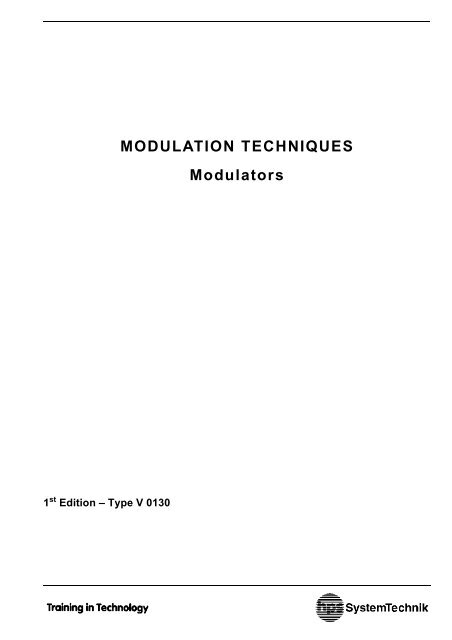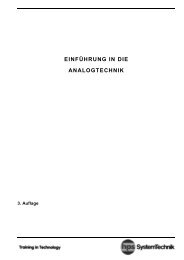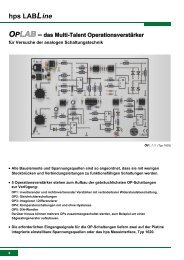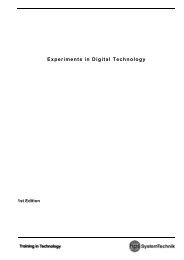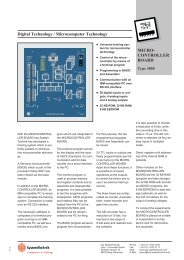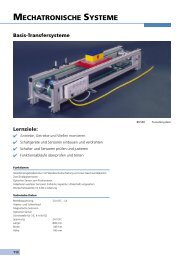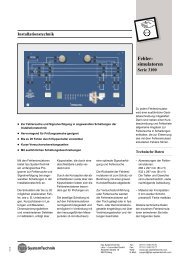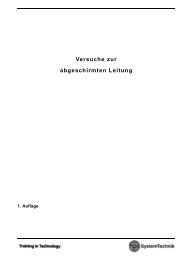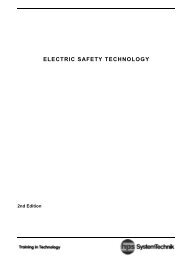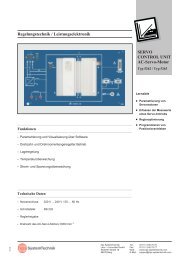MODULATION TECHNIQUES Modulators
MODULATION TECHNIQUES Modulators
MODULATION TECHNIQUES Modulators
Create successful ePaper yourself
Turn your PDF publications into a flip-book with our unique Google optimized e-Paper software.
1 st Edition – Type V 0130<br />
<strong>MODULATION</strong> <strong>TECHNIQUES</strong><br />
<strong>Modulators</strong>
© hps SystemTechnik<br />
Lehr- + Lernmittel GmbH<br />
hps SystemTechnik<br />
Altdorfer Strasse 16<br />
88276 Berg (Germany)<br />
Phone: +49 751 5 60 75 80<br />
Telefax: +49 751 5 60 75 17<br />
Internet: http://www.hps-SystemTechnik.com<br />
E-mail: export@hps-SystemTechnik.com<br />
Order No.: V 0130<br />
All rights reserved. No part of this publication may be reproduced, transmitted, stored in a retrieval system, nor translated into<br />
any human or computer language, in any form or by any means, electronic, mechanical, magnetic, optical, chemical, manual or<br />
otherwise, without the prior permission of hps SystemTechnik.<br />
9.6.7
V 0130 List of Contents I<br />
List of Contents<br />
Introduction . . . . . . . . . . . . . . . . . . . . . . . . . . . . . . . . . . . . . . . . . . . . . . . . . . . 1<br />
1. Fundamental theory of modulation technology . . . . . . . . . . . . . . . . . . . . . . . . . . . . 3<br />
2. Addition and multiplication . . . . . . . . . . . . . . . . . . . . . . . . . . . . . . . . . . . . . . . . 9<br />
2.1 The adder . . . . . . . . . . . . . . . . . . . . . . . . . . . . . . . . . . . . . . . . . . . . . . . . . . . 9<br />
2.2 The multiplier . . . . . . . . . . . . . . . . . . . . . . . . . . . . . . . . . . . . . . . . . . . . . . . . . 25<br />
3. Amplitude Modulation (AM)<br />
3.1 Theoretical introduction . . . . . . . . . . . . . . . . . . . . . . . . . . . . . . . . . . . . . . . . . . . 33<br />
3.2 Modulation on a non-linear characteristic . . . . . . . . . . . . . . . . . . . . . . . . . . . . . . . . . 35<br />
3.3 Amplitude modulation with a multiplier . . . . . . . . . . . . . . . . . . . . . . . . . . . . . . . . . . . 45<br />
3.4 Spectrum and bandwidth of the AM . . . . . . . . . . . . . . . . . . . . . . . . . . . . . . . . . . . . 51<br />
3.5 AM-DSB with suppressed carrier . . . . . . . . . . . . . . . . . . . . . . . . . . . . . . . . . . . . . . 55<br />
3.6 The multiplier in balanced modulator mode . . . . . . . . . . . . . . . . . . . . . . . . . . . . . . . . 57<br />
3.7 The multiplier in ring modulator mode . . . . . . . . . . . . . . . . . . . . . . . . . . . . . . . . . . . 61<br />
3.8 Single sideband modulation (SSB) . . . . . . . . . . . . . . . . . . . . . . . . . . . . . . . . . . . . . 65<br />
4. Angle modulation techniques<br />
4.1 Theoretical introduction . . . . . . . . . . . . . . . . . . . . . . . . . . . . . . . . . . . . . . . . . . . 73<br />
4.2 Generation of frequency modulated signals (FM) . . . . . . . . . . . . . . . . . . . . . . . . . . . . 75<br />
4.3 Measuring the frequency deviation . . . . . . . . . . . . . . . . . . . . . . . . . . . . . . . . . . . . . 79<br />
4.4 Determining the modulation index . . . . . . . . . . . . . . . . . . . . . . . . . . . . . . . . . . . . . 81<br />
4.5 Frequency spectrum of an FM oscillation . . . . . . . . . . . . . . . . . . . . . . . . . . . . . . . . . 85<br />
4.6 Generation of phase modulated signals (PM) . . . . . . . . . . . . . . . . . . . . . . . . . . . . . . . 91<br />
4.7 Generation of pulse frequency modulated signals (PFM) . . . . . . . . . . . . . . . . . . . . . . . 101<br />
4.8 Generation of pulse phase modulated signals (PPM) . . . . . . . . . . . . . . . . . . . . . . . . . 105
II List of Contents V 0130<br />
5. Digital modulation techniques<br />
5.1 Theoretical introduction . . . . . . . . . . . . . . . . . . . . . . . . . . . . . . . . . . . . . . . . . . 107<br />
5.2 Generation of amplitude shift keying signals (ASK) . . . . . . . . . . . . . . . . . . . . . . . . . . 115<br />
5.3 Spectrum of amplitude shift keying signals . . . . . . . . . . . . . . . . . . . . . . . . . . . . . . 119<br />
5.4 Generation of frequency shift keying signals (FSK) . . . . . . . . . . . . . . . . . . . . . . . . . . 129<br />
5.5 Spectrum of frequency shift keying signals . . . . . . . . . . . . . . . . . . . . . . . . . . . . . . 131<br />
5.6 Generation of phase shift keying signals (PSK) . . . . . . . . . . . . . . . . . . . . . . . . . . . . 133<br />
5.7 Spectrum of phase shift keying signals . . . . . . . . . . . . . . . . . . . . . . . . . . . . . . . . . 137<br />
6. Pulse modulation techniques<br />
6.1 Theoretical introduction . . . . . . . . . . . . . . . . . . . . . . . . . . . . . . . . . . . . . . . . . . 143<br />
6.2 Generation of a pulse amplitude modulated signal . . . . . . . . . . . . . . . . . . . . . . . . . . 145<br />
6.3 Frequency spectrum of the pulse amplitude modulated signal . . . . . . . . . . . . . . . . . . . 151<br />
6.4 Explanation of the sampling theorem . . . . . . . . . . . . . . . . . . . . . . . . . . . . . . . . . . 155<br />
6.5 Time-division multiplexing . . . . . . . . . . . . . . . . . . . . . . . . . . . . . . . . . . . . . . . . 159<br />
7. Pulse code modulation<br />
7.1 Theoretical introduction . . . . . . . . . . . . . . . . . . . . . . . . . . . . . . . . . . . . . . . . . . 165<br />
7.2 Experiments with pulse code modulator . . . . . . . . . . . . . . . . . . . . . . . . . . . . . . . . 169<br />
7.3 PCM multiplex generation . . . . . . . . . . . . . . . . . . . . . . . . . . . . . . . . . . . . . . . . 173<br />
8. Delta modulation<br />
8.1 Theoretical introduction . . . . . . . . . . . . . . . . . . . . . . . . . . . . . . . . . . . . . . . . . . 177<br />
8.2 Generation of delta modulated signals (DM) . . . . . . . . . . . . . . . . . . . . . . . . . . . . . . 179<br />
Solutions . . . . . . . . . . . . . . . . . . . . . . . . . . . . . . . . . . . . . . . . . . . . . . . . L 1 ... L 80<br />
Appendix . . . . . . . . . . . . . . . . . . . . . . . . . . . . . . . . . . . . . . . . . . . . . . . . A 1 ... A 3


